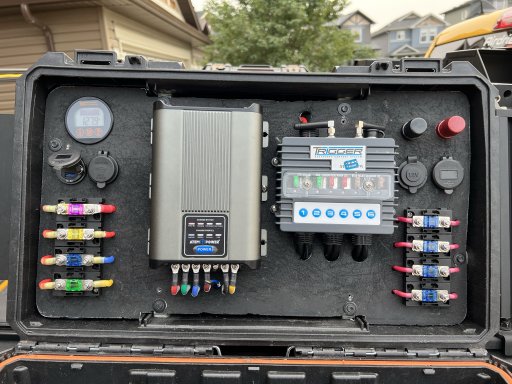If we were setting up a lead battery system today we'd go with a Blue Sea Systems 20A Battery Link . We ran a Blue Sea Systems Automatic Charge Relay (ACR) before we switched to lithium and it was fantastic up until it failed in Chile. When we returned to the States we contacted Blue Sea Systems and even though we had owned it for over 4 years they sent us a new one, having us send the broken one to them once we received the new unit so they could disassemble it and investigate the failure. We were the only ones that had one fail out of everyone we knew but we had installed ours to the van's frame which may have been what contributed to its failure. One thing we started to wish we had during our travels was a universal charger (100-240V AC) which is what is built into the Battery Link (as well as being a 170Amp ACR). An important caveat with running the Battery Link (besides being only for lead batteries - not Lithium) is your system must be entirely 12V (no converter), what most are in Overland Vehicles (24V for most European rigs but there are 24V Battery Links available). The link I provided above is to the North American 12V model but there is a bare wire version that opens up installation options.
Isolator recommendation? Redarc?
- Thread starter Uniquely Us Adventures
- Start date
-
Guest, UPDATE We went through the site migration runbook and completed all steps. We will need to complete the migration next week, but will leave the forums up for the weekend. A few days after maintenance, a major upgrade revision to the forum site will occur.

Pioneer II
- 9,324
- First Name
- Daniel
- Last Name
- Montelbetti
- Member #
-
41721
- Ham/GMRS Callsign
- HAM - KN6TKY & GMRS - WRQT727
- Service Branch
- FIRE/EMS
I removed the rear seats of the JK and built a raised platform to provided storage on the 60% passenger side, and a electrical box on the 40% driver side. The cabinet work is all prototype currently and we will rebuild it after a year or so of use and determining what works best for us. Most likely I will relocate the electrical into a higher cavity in the drawer system to reduce any chance of damage if I play submarine more than I should, battery would remain and the rest of the space would be more storage, just did not think it out before I installed it here.
This photo shows what the electrical section looks like from the exterior, cooling fan, inverter control panel, and compressor air gauge are on the face, open slot above holds tool bag and safety equipment, drawers above hold camera gear. A compression latch holds the electrical lid closed, lid and cabinet are hinged and fold back for access to the electrical components
View attachment 240704
Photo below shows component layout, RedArc Manager 30 on the rear wall, 100ah lithium battery on right, Redvision system on left side with we boost above, Renogy inverter on back side of front panel.
View attachment 240705
Closer view of interior, 12 volt computer fan in lower left corner is controlled via a make on rise thermostat and turns on if cabinet temp reaches 90 degrees, center section contains the bulk of wiring, battery sensors Fuses etc. Not seen is a heated mat under the battery controlled via the Redvision system to turn on battery heat if the temps get near freezing to that we are still able to provide a charge during winter camping. At the time I put all this together RedArc did not have thier inverters approved for sale in the US, would have been nice to be able to control it from the RedVision contol panel and app, may have to upgrade it and move the Renogy over to the WJ or Ram.
View attachment 240706
Removed the handle screws from my ARB fridge and made an adapter plate to mount the Redvision screen to the fridge, limited space in the JK and since it controls all the camping functions this was the perfect place for it. Used the flexible cable guide track from ARB to enclose and guide the fridge power cord and cat 5 cable to the display so no issues with it all sliding in and out with the fridge. One of these days I will have to peel the protective cover off the display lol... I can control the Redvison functions from the rear mounted panel, or from the app on the android tablet in the cockpit or phone. Its nice to be able to turn on camp lights from inside the roof top tent
View attachment 240707
The Manager 30 is fed from #4 battery cables connected to the main vehicle battery via a 50 amp circuit breaker under the hood (wire this large can defiantly cause a fire if it shorts out and is not overload protected, plus the breaker allows for a quick disconnect if I want to isolate the system. I could have grounded the system to the chassis under the Jeep, but wanted a dedicated ground back to the battery to ensure a clean supply. (I tend to run dedicated grounds to most electrical devices and lights, hate chasing a bad ground gremlin).
That’s an incredible build out! I love it! Thanks so much for the detailed description and pictures! Great lay out. Having access to the controls in the camper is the reason I went with switch pro. I like that ability to flip lights on when camping in the camper.. didn’t think about the c CC poker tremors issue. I’ll have the remember that.. I imagine it heats quickly that little fan keeps up? Again such a great build out and I know have a much bigger to do/wish list! Thanks again!

Enthusiast I
So I had a thought last night ….
I’m thinking of adding a continuous duty solenoid to the charging circuit as a backup incase I have another dcdc failure on a long trip, my thought is that then I can just throw a switch and when the truck is running it’ll charge the house batteries and isolate the start battery when things aren’t running.
Just an old school backup you might call it.
The management panel I built has the space to accommodate this easily.
it still looks a little sloppy to me but I kinda rushed some of the fab work to make my last trip, I have plans to cut a new panel that fits a little cleaner.

I’m thinking of adding a continuous duty solenoid to the charging circuit as a backup incase I have another dcdc failure on a long trip, my thought is that then I can just throw a switch and when the truck is running it’ll charge the house batteries and isolate the start battery when things aren’t running.
Just an old school backup you might call it.
The management panel I built has the space to accommodate this easily.
it still looks a little sloppy to me but I kinda rushed some of the fab work to make my last trip, I have plans to cut a new panel that fits a little cleaner.


Explorer I
I wonder if you could replace that switch with a relay energized by the truck's accessory power so you don't have to remember to flip the switch? Nice work!my thought is that then I can just throw a switch and when the truck is running it’ll charge the house batteries and isolate the start battery when things aren’t running.

Enthusiast I
Actually,I wonder if you could replace that switch with a relay energized by the truck's accessory power so you don't have to remember to flip the switch? Nice work!
My trigger system is already wired to an ignition source, and can set to stay on or switch off with the ignition so that part is already covered. That way the switch can stay off unless there’s a failure and then be switched on and not have to be thought about again until repairs can be made.

Trail Blazer III
- 4,847
- First Name
- Dave
- Last Name
- Ballard
- Member #
-
20527
- Ham/GMRS Callsign
- N7XQP
- Service Branch
- Fire/EMS/SAR
Just
While I don't have the same setup I do enjoy the same fast charging and it is nice for sure. Nothing like having your charging status hit "float" (trickle charge) within minutes of leaving camp. If you decide to pursue this route make sure to use a wire size calculator to properly size the wires/cables that you use - because nobody wants an unplanned campfire in the rig ;) Notice the big fat cables that @OTH Overland uses in certain runs in his setup (vehicle charging system to charger at least).
Greg makes a great point! undersized wires will get hot, not perform properly and likely to leave you with an insurance claim, oversizing is just extra cost. Just as important as selecting the correct wire size is using quality wire, a lote of the wire on Amazon and similar places is CCA (copper clad aluminum) The headline will say copper, but fine print states it's just clad. Aluminum does not conduct as well (handles less amperage than same size copper) and work hardens faster under vibration than copper. high loads will cause aluminum to expand and contract loosening connection points. All the large feeders in my build are solid copper with fine strands (sometimes called welding leads) very flexible with a good insulation covering and not likely to cause any issues in my lifetime. #4CCA wire is about $1.25 per foot, while good full copper is over $2.00 per foot. Never use solid (non stranded) wire in a vehicle, the vibration will work harden it and cause it to fail, plus its a pain to run.

Explorer I
That is what I used for the long run from the engine compartment to the bed of my truck. All copper 6 gauge; I have a long run to a 30 amp charger.welding leads

Explorer I
I have a Renogy DCC50s in my truck that handles 50 amps from the alternator and 200W solar to a 100Ah lithium battery.
Works flawlessly and has a bluetooth adapter (purchased separately) to monitor the battery.
Its not as fancy as the redarc version but a lot more affordable.
Works flawlessly and has a bluetooth adapter (purchased separately) to monitor the battery.
Its not as fancy as the redarc version but a lot more affordable.

Explorer I
I have the 30 amp renogy and the BT module is awesome. Can monitor system status while driving or at camp from a decent distance away.I have a Renogy DCC50s in my truck that handles 50 amps from the alternator and 200W solar to a 100Ah lithium battery.
Works flawlessly and has a bluetooth adapter (purchased separately) to monitor the battery.
Its not as fancy as the redarc version but a lot more affordable.

Protector III
- 14,032
- First Name
- Dimitri
- Last Name
- Raptis
- Member #
-
22608
- Ham/GMRS Callsign
- 4
I would strongly recommend the CTEK charger, Swedish technology that is an isolator, works with smart alternators, solar panels MPPT, and trickle charges the starter battery when required.Any one running the Red Arc SMART START BATTERY ISOLATOR & WIRING KIT 12V or have a high quality recommendation for an isolator? I want to run a dual battery setup.. want a good long lasting isolator..

Pioneer II
- 9,324
- First Name
- Daniel
- Last Name
- Montelbetti
- Member #
-
41721
- Ham/GMRS Callsign
- HAM - KN6TKY & GMRS - WRQT727
- Service Branch
- FIRE/EMS
Interesting I’ll check it out thank you for the recommendation!I would strongly recommend the CTEK charger, Swedish technology that is an isolator, works with smart alternators, solar panels MPPT, and trickle charges the starter battery when required.Any one running the Red Arc SMART START BATTERY ISOLATOR & WIRING KIT 12V or have a high quality recommendation for an isolator? I want to run a dual battery setup.. want a good long lasting isolator..

